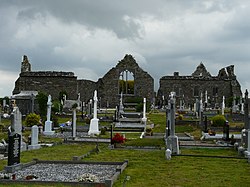Ballylongford
| Ballylongford Irish: Béal Átha Longfoirt | |
| County Kerry | |
|---|---|
 Lislaughtin Abbey ruins | |
| Location | |
| Grid reference: | Q996449 |
| Location: | 52°32’46"N, 9°28’41"W |
| Data | |
| Population: | 415 (2022) |
| Local Government | |
Ballylongford (historically Bealalongford) is a village near Listowel in northern County Kerry. The name from Béal Átha Longfoirt, meaning 'ford-mouth of anchorage'.[1]
The village is near the estuary of the Ballyline River,[2] on Ballylongford Bay, a tidal estuary of the River Shannon, close to Carrigafoyle Island and on the coast road between Tarbert and the seaside town of Ballybunion.
The farmland in the area is used primarily for dairying, which is a mainstay of the local economy.[3][4]
Two miles to the north, on Carrigafoyle Island, stands the castle and anchorage commemorated in the name of the village. For centuries, Ballylongford shared the political, military and religious fate of the castle and the nearby Franciscan Lislaughtin Abbey.[3][5]
History

Carrigafoyle Castle was built between 1490 and 1500 by Conchuir Liath Uí Conchuir (Connor Liath O’Connor) using a design borrowed from the Normans.[6] In addition to its windows and archways, it features a spiral staircase of 104 steps that visitors can climb today.[7] The castle, now a listed National Monument, stands 100 feet high and its battlements provide views of the estuary and the monastic Scattery Island in County Clare. The O'Connors of Kerry held political sway from this strategic base which allowed them to "inspect" ships passing to and from the port of Limerick. Thus, "taxation" and smuggling were the main sources of income. The castle was fortified and the narrow spiral staircase ascends clockwise thus disadvantaging any attacker.
In 1580, during the Second Desmond Rebellion, the castle was defended by a garrison composed of some 70 Irish, Italian and Spanish troops, led by Captain Julian, an Italian.[7][8] The Siege of Carrigafoyle Castle by Elizabethan forces under Lord Justice Sir William Pelham began on Palm Sunday. After two days, it was breached by cannon fire and taken, following which the surviving defenders were all hanged. The cannon breach remains visible to this day. Towards the end of the Nine Years War, taking advantage of the distraction of the English forces, Chieftain John O'Connor briefly re-occupied the castle only to be put out again in 1603 by George Carew, the Governor of Munster.[9]
King James I restored the castle to the O'Connors in 1607 but in 1651 during the Cromwellian conquest of Ireland, it was again captured, this time by Cromwellian forces under Edmund Ludlow. Ludlow was Henry Ireton's second in command and, after Ireton's death, commander in chief in Ireland. Ludlow ensured that the castle could never again be fortified and garrisoned, by knocking the outer defensive walls.[9]
The O'Connor lands were confiscated under the Act for the Settlement of Ireland of 1652 and given to William Sandes of Cumberland, who had arrived in Ireland with Oliver Cromwell in 1649. Following the |restoration of the monarchy the lands were subsequently granted to Trinity College Dublin in 1666. The college remained the principal landlord in the Ballylongford area up to the passage of the Land Act 1903. Some land titles are still vested in the college to this day.

On the other side of the creek, the O'Connors built the Friary of Lislaughtin in 1478, known locally as Lislaughtin Abbey (Lios Laichtin, meaning Lachtin's Enclosure).[10] St Lachtin was the first to preach Christianity in the area. Two of the O'Connor chiefs are buried within its walls. The Abbey was raided twice by English forces coinciding with the military action against Carrigafoyle Castle. The Abbey was dissolved in the 17th century.[11] A processional cross, possibly buried by the friars for safekeeping, survived the raids and was later discovered by a farmer.[12] This processional cross, known as Lislaughtin Cross, is now on display in the National Museum in Dublin. Today, the Abbey and its grounds serve as the town's primary Roman Catholic cemetery.
The village in its present form dates from the end of the eighteenth century, though a bridge over the ford existed long before then. The old bridge was destroyed by flood in 1926. A reinforced concrete bridge was completed in 1930 and stands to this day. Photographs taken at the turn of the century show the village to have been largely made up of thatched houses, but many of these were burned by the Black and Tans during the War of Independence.
A concrete coastal artillery fort, Fort Shannon, is located four miles from the village. Constructed in 1940, it is the only such fortification built by the Irish Defence Forces during Second World War.
Sport
- Ballylongford GAA
References
- ↑ Béal Átha Longfoirt / Ballylongford: Placenames Database of Ireland
- ↑ "Flood Risk Review Report – UoM 24 Ballylongford". Jacobs/Office of Public Works (Ireland). 2011. http://shannoncframstudy.jacobs.com/docs/frr/Appendix%20D3-UoM24/FRR%20Ballylongford%20V0_A.pdf.
- ↑ 3.0 3.1 "North Kerry - Ballylongford". Go Kerry Tourism. http://www.gokerry.ie/locations/ballylongford/.
- ↑ "Ballylongford Snaps". https://ballylongfordsnaps.com/. "The mainstay of the local economy is dairy farming, with tourism also important"
- ↑ Samuel Lewis (1837). "Ballylongford". A Topographical Dictionary of Ireland. Lewis. https://www.libraryireland.com/topog/B/Ballylongford-Iraghticonnor-Kerry.php.
- ↑ "Carrigafoyle Castle C15th Anglo Norman". http://www.neothemi-ireland.com/norman2.htm.
- ↑ 7.0 7.1 "Historic Houses and Castles - Carrigafoyle Castle". Fáilte Ireland. https://www.discoverireland.ie/Arts-Culture-Heritage/carrigafoyle-castle/15653.
- ↑ "Beautiful Ballylongford; where the past comes to life". The Kerry Man. 1 September 2010. https://www.pressreader.com/ireland/the-kerryman-south-kerry-edition/20100901/285155764737192.
- ↑ 9.0 9.1 "Carrigafoyle Castle". Go Kerry Tourism. http://www.gokerry.ie/index.php?action=locations&location_id=51&page_id=45.
- ↑ "Lios Laichtín / Lislaughtin". Irish Placenames Commission. https://www.logainm.ie/en/24074.
- ↑ "Lislaughtin Abbey". 22 February 2014. http://www.kerrygems.com/attraction/lislaughtin-abbey/.
- ↑ "Lislaughtin Franciscan Friary". Monastic Ireland. http://monastic.ie/history/lislaughtin-franciscan-friary/.